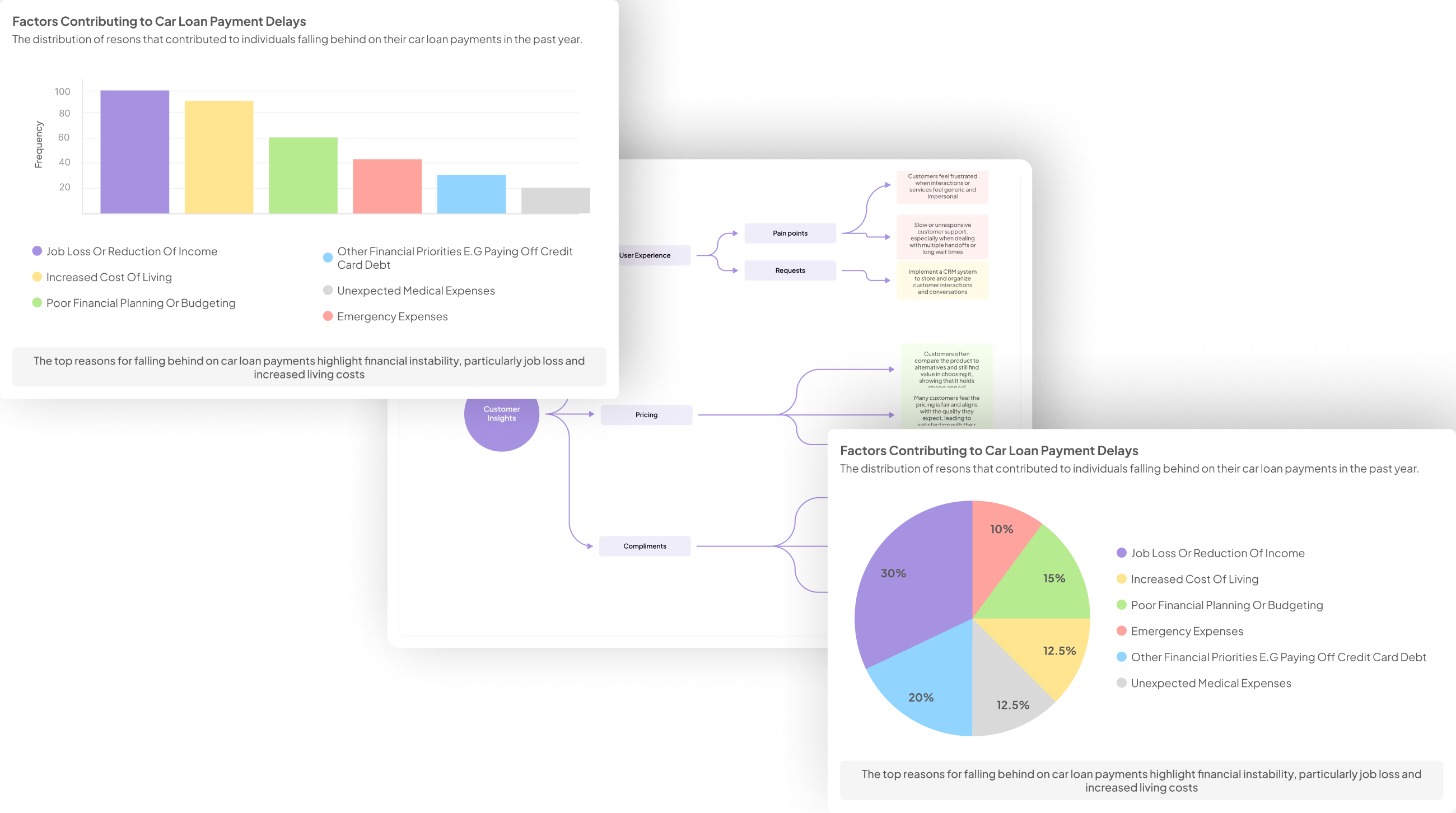Text Analytics Models: Key Concepts for Beginners
-
Bella Williams
- 10 min read
Text analytics is a powerful tool that can unlock the hidden insights within vast amounts of text data. Understanding Text Analytics Fundamentals is crucial for beginners eager to navigate this complex field. By transforming unstructured text into structured data, you can gain valuable insights that drive informed decision-making in various industries.
This section introduces essential concepts of text analytics, focusing on how to analyze data effectively. Equipped with techniques such as sentiment analysis and topic modeling, practitioners can uncover trends and sentiments hidden in customer feedback, social media interactions, and more. Familiarity with these fundamentals will empower you to engage with text data confidently, making informed choices based on valuable insights.
Generate visualizations from your qualitative data. At Scale.

Understanding Text Analytics Fundamentals: Core Concepts
Text analytics fundamentals serve as the foundation for understanding how to derive insights from vast amounts of textual data. Essentially, text analytics involves the application of natural language processing and algorithms to analyze and interpret text. By employing these methodologies, businesses can identify sentiments, categorize topics, and extract relevant patterns from customer conversations or market research data.
Key components essential to text analytics include data collection, preprocessing, analysis, and visualization. Firstly, data collection involves gathering relevant text from various sources, such as customer feedback or social media. Next, preprocessing cleans and prepares this data for analysis, often involving steps like tokenization and removing stop words. The analysis stage applies algorithms to interpret the data, followed by visualization to present findings in an accessible manner. Understanding these core concepts equips individuals to effectively navigate the intricate realm of text analytics and extract actionable insights from unstructured data.
What is Text Analytics?
Text analytics is the process of extracting valuable insights from unstructured textual data. This method combines linguistics and machine learning to convert qualitative information into quantitative analysis. By employing natural language processing (NLP), text analytics allows organizations to interpret sentiments, trends, and patterns hidden within large volumes of text.
The fundamental aspects of text analytics include data collection, preprocessing, and analysis. First, data collection involves gathering text from various sources, such as customer feedback or social media. Next, preprocessing requires cleaning and organizing the text to enhance accuracy. Finally, analysis using algorithms helps identify sentiments or themes, providing actionable insights for businesses. Understanding these core components is crucial for anyone looking to delve into text analytics and leverage its potential for informed decision-making.
Key Components of Text Analytics Fundamentals
Text analytics fundamentals encompass various key components essential for effective analysis and insight extraction. The first component is data collection, which involves gathering text data from diverse sources like customer feedback, social media, and support conversations. This step provides the raw material necessary for any further analysis. Next comes data preprocessing, where the collected text is cleaned and structured for analysis. Tasks such as tokenization, stopword removal, and stemming play vital roles here.
Another critical component is feature extraction, which transforms the cleaned text into numerical representations suitable for modeling. Techniques like TF-IDF (Term Frequency-Inverse Document Frequency) help in highlighting the importance of specific terms within the text corpus. Finally, model selection is crucial, with options ranging from machine learning algorithms to deep learning approaches, allowing analysts to derive actionable insights. Understanding these key components is foundational for anyone stepping into text analytics.
Evaluate Performance on Customer Calls for Quality Assurance.
Text Analytics Fundamentals: Exploring Common Models
Text analytics is an exciting field that allows us to gain insights from text data effectively. When exploring Text Analytics Fundamentals, several common models come into play. Understanding these models is essential for beginners seeking to leverage text analytics for various applications, including business intelligence, customer feedback analysis, and market research.
Key models in text analytics include sentiment analysis, which helps identify emotional tones in text, enabling organizations to gauge public opinion. Additionally, topic modeling uncovers themes and trends in large datasets, offering invaluable context about customer interests and preferences. By exploring these common models, beginners will establish a solid foundation in text analytics, equipping them with the skills to analyze and utilize textual information more effectively. This knowledge not only empowers individuals but also fosters a deeper understanding of their audience's needs and sentiments.
Sentiment Analysis: A Beginner’s Guide
Sentiment analysis serves as a powerful tool to interpret the emotional tone behind textual data. By assessing customer feedback, social media posts, and reviews, businesses can gauge public sentiment toward their products or services. Understanding sentiment not only aids in comprehending customer opinions but also helps identify trends that influence purchasing decisions.
To embark on your sentiment analysis journey, it’s essential to grasp a few key concepts. First, lexicon-based approaches utilize predefined lists of words associated with positive or negative sentiments. Next, machine learning techniques involve training models on labeled data to predict sentiment effectively. Finally, natural language processing (NLP) plays a crucial role by enabling machines to understand and analyze human language better. Familiarizing yourself with these elements will equip you with a foundational understanding of sentiment analysis, unlocking valuable insights into user attitudes and behavior.
Topic Modeling: Discovering Hidden Themes
Topic modeling is a technique used in text analytics to uncover hidden themes within large collections of text. It allows you to sift through extensive data and identify clusters of related words and phrases, thus revealing underlying topics that may not be immediately obvious. This process is essential in transforming raw text into meaningful insights, which enables better decision-making.
By applying topic modeling, users can discover patterns in customer feedback, interviews, or even social media conversations. Imagine a scenario where numerous customer reviews are analyzed; topic modeling organizes this data, highlighting common sentiments and concerns. As a result, businesses can address customer pain points more effectively, leading to improved products and services. Ultimately, understanding and implementing topic modeling empowers organizations to derive valuable insights from their text data, enhancing their ability to respond to customer needs and emerging trends.
Conclusion: Embracing the World of Text Analytics Fundamentals
The journey through the world of text analytics fundamentals offers valuable lessons for aspiring analysts. As you explore various models and concepts, you gain insights into how text can be transformed into meaningful information. Understanding the core principles of text analytics unlocks potential applications across numerous fields, empowering you to make data-driven decisions.
Embracing these fundamentals is the first step toward mastering text analytics. Whether analyzing customer sentiments or uncovering hidden themes, each concept enhances your analytical skill set. By embracing these foundations, you can effectively contribute to optimizing experiences and driving results in your organization.







